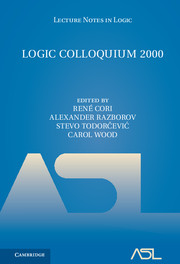Book contents
- Frontmatter
- Introduction
- Contents
- K. Jon Barwise (1942-2000)
- TUTORIALS
- PHOTOGRAPHS
- ARTICLES
- Bounded forcing axioms and the size of the continuum
- Hilbert's wide program
- Rigidity conjectures
- Metapredicative and explicit Mahlo: a proof-theoretic perspective
- A two-dimensional tree ideal
- Psychology looks hopefully to logic
- Russell's logics
- Partitioning pairs of uncountable sets
- Aspects of the Turing jump
- Liouville functions
- References
Analytic and pseudo-analytic structures
from ARTICLES
Published online by Cambridge University Press: 27 June 2017
- Frontmatter
- Introduction
- Contents
- K. Jon Barwise (1942-2000)
- TUTORIALS
- PHOTOGRAPHS
- ARTICLES
- Bounded forcing axioms and the size of the continuum
- Hilbert's wide program
- Rigidity conjectures
- Metapredicative and explicit Mahlo: a proof-theoretic perspective
- A two-dimensional tree ideal
- Psychology looks hopefully to logic
- Russell's logics
- Partitioning pairs of uncountable sets
- Aspects of the Turing jump
- Liouville functions
- References
Summary
One of the questions frequently asked nowadays about model theory is whether it is still logic. The reason for asking the question is mainly thatmore andmore ofmodel theoretic research focuses on concretemathematical fields, uses extensively their tools and attacks their inner problems. Nevertheless the logical roots in the case of model theoretic geometric stability theory are not only clear but also remain very important in all its applications.
This line of research started with the notion of a κ-categorical first order theory, which soon mutated into the more algebraic and less logical notion of a κ-categorical structure.
A structure M in a first order language L is said to be categorical in cardinality κ if there is exactly one structure of cardinality κ (up to isomorphism) satisfying the L-theory of M.
In other words, if we add to Th(M) the (non first-order) statement that the cardinality of the domain of the structure is κ, the description becomes categorical.
The principal breakthrough, in the mid-sixties, from which stability theory started was the answer to J. Los’ problem.
THE MORLEY THEOREM. A countable theory which is categorical in one uncountable cardinality is categorical in all uncountable cardinalities.
The basic examples of uncountably categorical structures in a countable language are:
1. Trivial structures (the language allows only equality);
2. Abelian divisible torsion-free groups; Abelian groups of prime exponent (the language allows +, =); Vector spaces over a (countable) division ring;
3. Algebraically closed fields in language.
Also, any structure definable in one of the above is uncountably categorical in the language which witnesses the interpretation.
The structures definable in algebraically closed fields, for example, are effectively objects of algebraic geometry.
As a matter of fact the main logical problem after answering the question of J. Los was what properties of M make it κ-categorical for uncountable κ?
The answer is now reasonably clear:
The key factors are measurability by a dimension and high homogeneity of the structure.
This gave rise to (Geometric) Stability Theory, the theory studying structures with good dimensional and geometric properties (see [Bu] and [P]). When applied to fields, the stability theoretic approach is in many respects very close to Algebraic Geometry.
- Type
- Chapter
- Information
- Logic Colloquium 2000 , pp. 392 - 408Publisher: Cambridge University PressPrint publication year: 2005
References
- 3
- Cited by



